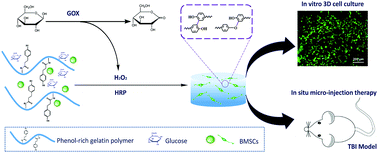A dual-enzymatically cross-linked injectable gelatin hydrogel loaded with BMSC improves neurological function recovery of traumatic brain injury in rats†
Abstract
Injectable hydrogels can perfectly fill defective areas and thereby show promise as therapeutic implants or cell/drug delivery vehicles in traumatic brain injury (TBI) or other tissue repair. In this study, an injectable gelatin hydrogel in situ dual-enzymatically cross-linked by glucose oxidase (GOX) and horseradish peroxidase (HRP) was synthesized and optimized, and the therapeutic effect of this hydrogel encapsulated with bone mesenchymal stem cells (BMSC) for TBI rats was investigated. By changing the GOX content, we found that this hydrogel cross-linked by 0.1 U mL−1 GOX possesses better cytocompatibility than that with a higher GOX content, and minimized immune response in vivo. More importantly, this hydrogel loaded with BMSC could significantly accelerate the healing process of a damaged region, facilitate the survival and proliferation of endogenous nerve cells probably by nutrition supply and apoptosis suppression, and consequently promote the neurological function recovery of the TBI rat model. All these findings highlight that this injectable and BMSC-laden gelatin hydrogel has enormous potential for TBI therapy and other tissue regeneration strategies.



 Please wait while we load your content...
Please wait while we load your content...